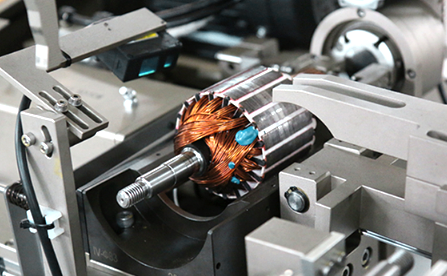What are the common sensor failures and their solutions for brushless motor motor automatic rotor dynamic balancing machine?
The following are common sensor failures and solutions for brushless motor motor automatic rotor dynamic balancing machines:
I. Types of sensor failures
1. Sensor signal loss
Failure phenomenon: The display of the dynamic balancing machine shows that the sensor signal is interrupted or missing, and it is impossible to carry out measurement and balance analysis normally.
Cause of failure:
Loose or detached sensor wiring.
Sensor internal circuit failure, such as chip damage, line breakage, etc..
Strong external electromagnetic interference, affecting the sensor signal transmission.
2. Sensor measurement accuracy degradation
Fault phenomenon: the measured rotor unbalance deviates greatly from the actual value, and the balancing effect is not good.
Fault causes:
Sensor probe contamination, such as stained with oil, dust and other impurities, affecting the sensing accuracy.
Sensor aging, performance gradually decline.
Improper installation position, resulting in inaccurate sensing range.

3. Sensor zero drift
Fault phenomenon: Even if the rotor is in balance, the sensor still shows a certain unbalanced value, and the value is not stable.
Fault cause:
Changes in the parameters of the internal components of the sensor, such as resistance, capacitance and other parameters drift.
Ambient temperature changes on the sensor's internal components have an impact on the zero reference point shift.
Second, the solution
1. For loose or detached sensor wiring
Regularly check the wiring of the sensor to ensure that the wiring is firm and reliable. Before running the equipment, carefully check whether the wiring is tightly inserted, if loose, re-inserted in a timely manner.
Use waterproof connectors and cables to avoid loose wiring due to vibration or external factors.
2. For the sensor internal circuit failure
Use professional circuit testing equipment, such as oscilloscopes, multimeters, etc., to conduct a comprehensive test of the sensor circuit.
If the chip is detected damaged, the need to replace the same type of sensor chip; if the line is broken, you need to carefully find the location of the break, welding repair or replacement of damaged lines.
In the sensor installation location near the set of shielding to reduce the impact of external electromagnetic interference on the sensor circuit.
3. To solve the sensor probe pollution
Develop an equipment cleaning program, regular cleaning of the sensor probe. You can use a clean soft cloth dipped in the appropriate amount of alcohol to gently wipe the probe surface to remove oil and dust.
Cleaning operations in the equipment downtime state to avoid damage to the probe during operation.
4. Coping with sensor aging
Regularly calibrate the sensor, according to the service life of the sensor and calibration results, to determine whether the sensor needs to be replaced. The general service life of the sensor is 2 - 3 years, after exceeding the service life, the measurement accuracy will be significantly reduced, and should be replaced in time.
Choose reliable quality and well-known brand sensors to reduce the risk of sensor aging from the source.
5. Calibrate sensor installation position
When installing the sensor, strictly follow the requirements of the equipment manual to ensure that the installation position of the sensor is accurate and the sensing range covers the key positions of the rotor.
After installation, use the calibration tool to calibrate the sensor mounting position to ensure that it can accurately sense the rotor imbalance information during operation.
6. Handling sensor zero drift
Use the zero calibration function to zero calibrate the sensor after each power-up of the equipment or before measurement to bring the sensor back to the initial reference state.
If the zero drift is more serious, it may be necessary to disassemble the sensor for inspection, replace the internal components or replace the sensor as a whole. At the same time, to maintain the relative stability of the working environment temperature of the equipment to reduce the impact of temperature changes on the sensor.
※ If the above ways and means are still unable to solve the equipment failure, please contact Xinhui Electromechanical Equipment Co., Ltd. technical specialists through the page chat tool for help.







